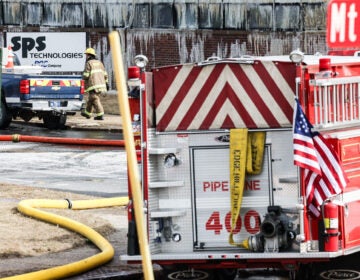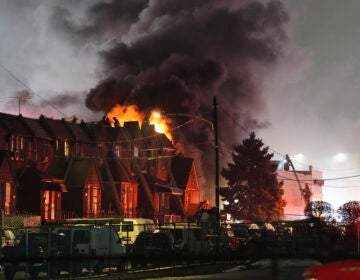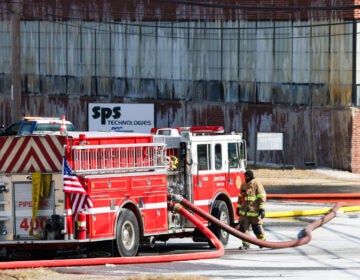Officials say the air is safe near the Jenkintown SPS fire. Residents remain on edge
Residents say officials should have communicated in “real-time” and released details about air monitoring and chemicals at the plant sooner.
Listen 1:01
Firefighters battle a blaze at SPS Technologies in Jenkintown, Pa., Monday, Feb. 17, 2025. (AP Photo/Matt Rourke)
From Delco to Chesco and Montco to Bucks, what about life in Philly’s suburbs do you want WHYY News to cover? Let us know!
Since the fire at SPS Technologies in Jenkintown erupted Monday evening, local officials have issued numerous text alerts and press releases to keep the community informed. Early messages mentioned smoke, particulates and “concerns of air quality.” Officials have now declared the area safe, even as the fire continues to smolder.
But some residents say there was a lag in communication and lack of transparency about the chemicals stored at the manufacturing facility and the air monitoring process.
“I knew the kind of chemicals that were stored there,” said William Durphy, who used to work as a cook in the company’s cafeteria and whose grandfather worked at the facility for nearly 50 years. “I myself and other neighbors were outside during all this not knowing … it was Standard Pressed Steel that was on fire.”
He recalled watching black smoke rise from the facility Monday night.
“Plumes of black smoke and … ash were all coming directly at our houses,” he said.
It would be more than an hour before Durphy and other residents received an alert from ReadyMontco directing them to shelter in place.
“They should have evacuated us then,” Durphy said. “That’s when everything was cooking. … You could hear the 55 gallon drums popping. There was explosions all night.”
The changing guidance from officials over time should not cause residents to distrust the officials’ statements, said Arthur Frank, a professor of public health and medicine at Drexel University and member of Philadelphia’s Air Pollution Control Board. It’s common during public health emergencies to provide changing information as the situation evolves over time, Frank said.
At a press conference Thursday, officials said most of the chemicals onsite were stored in a facility that was spared from the blaze.
How different agencies are monitoring air contamination
As early as Tuesday morning, agencies including the Pennsylvania Department of Environmental Protection and U.S. Environmental Protection Agency monitored air quality in the area, according to communications sent out by Montgomery County and Abington Township.
The ongoing air monitoring by DEP and EPA is testing for several sizes of fine particulate matter, hydrogen cyanide, chlorine, volatile organic compounds, hydrogen sulfide and sulfuric acid, according to DEP.
In addition to roving monitoring with handheld devices, there are two stationary monitors set up in the community near the SPS site. One is located at the railroad tracks between the plant and the homes directly southeast of the plant and the other is located at the Jenkintown middle and high school complex.
“Air quality monitors have not detected any chemicals of concern in the air outside of the facility,” the DEP website reads.
Philadelphia’s Air Management Services also monitored the air next to the facility Tuesday afternoon for different compounds. The agency used a mobile monitoring van that measures unhealthy or toxic pollutants, including particulate matter and formaldehyde, in real time, as well as a canister that collects a snapshot of air to be analyzed in a lab for pollutants, including cancer-causing benzene and dangerous ethylene oxide.
Neither method identified concerns for public health, said Philadelphia Department of Public Health spokesperson James Garrow.
Best practices for air monitoring during an incident like this include sampling at multiple locations — including at the facility’s fence line and deeper into the community, said David Hess, former secretary of Pennsylvania’s Department of Environmental Protection. Air monitoring should also be continuous and should test for many different chemicals, especially when the potential pollutants are unknown, he said.
Residents wanted more ‘real-time’ communication
Alan Everett and his wife, Joanne O’Connor, live directly east of the facility on Runnymede Avenue with their daughter, two cats, a dog and a chinchilla. Everett said they fled to a hotel Monday night as embers were falling on their property and “thick, black acrid smoke” surrounded them.
“Conditions outside the house were really bad, you know, bad visibility, bad odor,” Everett said. “You couldn’t really breathe that well inside the house.”
O’Connor wants real-time status updates on the fire itself to determine how much of it is still burning and when demolition or other flare-ups could be expected.
“I really don’t want to be around when there is demolition, even though they’re going to hose down dust, because I do feel that there’s going to be stuff in the air, and I cannot be around that, you know, for my health,” O’Connor said.
Rebecca Kane, who lives in an apartment near the facility, applauded first responders and Jenkintown Police and borough officials for their response to the disaster, but said at the county level, she would have preferred clearer communication and more information about environmental testing.
“Some clearer transparency, just so we can look at that information for ourselves,” she said.
William Thomas, a photographer who lives about a mile away from the site of the fire, said officials should have told residents what chemicals were present in the building and the type of air monitoring they were doing sooner.
“Is vinyl chloride in the building? Was that burning? Is this like an East Palestine situation, where you know years from now people are going to be getting sick and coming down with cancers?” Thomas said. “It would be nice to have some transparency.”
Before officials sent out the first shelter-in-place alert late Monday night, Thomas decided to spend the night at his mom’s house in Bucks County — because he said the smoke had left a haze and chemical smell inside his home. He rushed to pack bags, put on a surgical mask and walked to his car.
“As soon as I went outside … my throat was immediately starting to burn,” he said.
What kind of chemicals were stored at SPS Technologies?
The facility handled chemicals that can cause health problems for those exposed at high levels in 2023, according to the EPA’s Toxic Release Inventory. These included chromium, which can cause cancer depending on its form and nitric acid, which can produce poisonous gases in a fire and enhance the combustion of other substances. In the last 10 years, the site has also handled chemicals including nickel, nitrate compounds, cobalt, copper and poisonous cyanide compounds.
The Philadelphia Inquirer reported the company has also used electroplating baths containing cadmium and silver, and has handled solvent wastes. The Department of Environmental Protection did not respond to a request for a full list of chemicals stored at the facility at the time of the fire.
SPS Technologies’ parent company, PCC Fasteners, did not respond to questions.
SPS Technologies has received repeated violations in recent years related to the labeling of waste, according to Pennsylvania DEP records.
In 2023, the EPA fined the facility over $100,000 for operating without a permit, failing to determine hazardous waste, failing to keep containers of hazardous waste closed and failing to maintain an adequate contingency plan.
According to Abington Police, SPS says it is currently moving chemicals that did not burn in the fire offsite.
“We regret the significant impact the fire has had on our neighbors, and we will be reaching out to the community in the days and weeks ahead,” the company said in a statement shared by Abington Township.
SPS has established a community hotline. Residents can reach out by phone at 215-572-3326 or by email at contactSPS@pccairframe.com.
‘I wish people were less skeptical’
Frank, the Drexel University professor, said residents should feel reassured their air and water are safe to breathe and drink following information released by environmental and health officials.
“There’s no reason not to tell the truth to people … not finding [chemicals] in the Delaware [River], where the city of Philadelphia gets its water, is reassuring,” he said. “There could well be some toxic materials, but I would hope that they would continue to measure, and if they did find anything of concern that they would initiate an appropriate cleanup.”
During emergencies, officials use their best judgement at the time — and advice to residents sometimes changes.
“That doesn’t mean anybody’s hiding anything. That doesn’t mean that there was anything inappropriate being done,” Frank said. “[An evacuation order] is a decision you make thoughtfully … Does that mean we always get it right? No. I wish people were less skeptical. I wish people would understand that judgments are made with incomplete information and everybody does the best they can.”
Some worry about long-term health impacts, despite assurances
Kane evacuated to a hotel and plans to stay there at least until Friday morning. She said as of Thursday there is still “a chemical odor” on the street and in her apartment.
“When we can clearly smell that there’s something in the air and we can clearly still see charred plastic and ash on our lawns, it is hard, I think, for the residents to go home and sit in your living room and have a cup of coffee and just relax and go about their lives,” she said.
Kane said she worries about the future.
“I am currently looking for homes in the borough,” she said. “I want to start my family in the borough. It’s scary to me to think that there could be some kind of long-term, silent effects, whether it’s through air or water or in the soil.”
Durphy, the resident who worked at the SPS Technologies cafeteria decades ago, said his car and lawn is covered with ash. He worries rain could transfer toxins from the ash to the soil and affect his dogs or grandchildren.
“I have seven grandkids,” he said. “What do I say, if there’s issues with my lawn — ‘You guys can’t come here anymore?’”
Durphy didn’t evacuate and said he’s been experiencing tightness in his chest.
Abington Township has been working with federal, state, county, municipal and local officials to monitor the health risks of the fire, said Abington Assistant Township Manager Ashley McIlvaine.
“Public safety is the number one priority of Abington Township, Jenkintown Borough, and Cheltenham Township and any detected health risks will be immediately communicated and a response initiated,” she said.
McIlvaine advised residents with immediate health concerns or questions to call the Montgomery County Office of Public Health or the Pennsylvania Department of Health.

Get daily updates from WHYY News!
WHYY is your source for fact-based, in-depth journalism and information. As a nonprofit organization, we rely on financial support from readers like you. Please give today.












